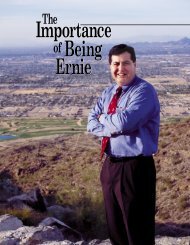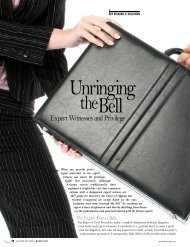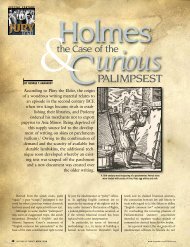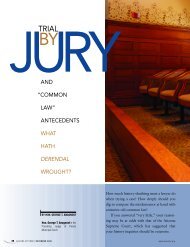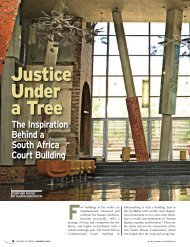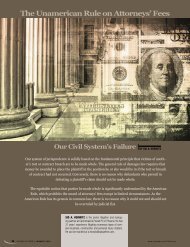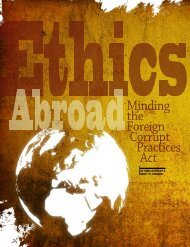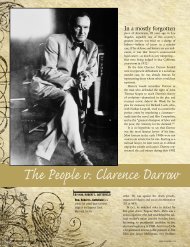Settlement Conferences in Criminal Court - Lawyers
Settlement Conferences in Criminal Court - Lawyers
Settlement Conferences in Criminal Court - Lawyers
- No tags were found...
Create successful ePaper yourself
Turn your PDF publications into a flip-book with our unique Google optimized e-Paper software.
It is no exaggeration to say thatthe Maricopa County Superior <strong>Court</strong>is both a large court, and a well-regardedone. It serves a grow<strong>in</strong>g and diversepopulation, and it often is at the forefrontof court and jury adm<strong>in</strong>istration.One of those groundbreak<strong>in</strong>gprograms was the <strong>in</strong>stitution of crim<strong>in</strong>alsettlement conferences.<strong>Settlement</strong> <strong>Conferences</strong><strong>in</strong> Crim<strong>in</strong>al <strong>Court</strong>BY HON. ROBERT L. GOTTSFIELD AND MITCH MICHKOWSKI, Ph.D.Hon. Robert L. Gottsfield is a retired but called-backfull-time judge of the Superior <strong>Court</strong>, Maricopa County, whocurrently conducts 40 to 60 settlement conferences a month.Mitch Michkowski is the court’s Civil <strong>Court</strong>Adm<strong>in</strong>istrator and Senior Researcher.8 ARIZONA ATTORNEY APRIL 2007
A Busy <strong>Court</strong>The Superior <strong>Court</strong> of Arizona <strong>in</strong> MaricopaCounty is the fifth-largest trial court <strong>in</strong> the UnitedStates, consist<strong>in</strong>g of 94 judges and 52 commissioners,of which 28 judges and 29 commissioners are assigned acrim<strong>in</strong>al calendar. In fiscal year 2006, end<strong>in</strong>g June 30, therewere 40,928 crim<strong>in</strong>al cases filed, <strong>in</strong> addition to 36,691 civil casesand 50,878 family court cases. This added up to a docket of 157,956total case fil<strong>in</strong>gs. With respect to crim<strong>in</strong>al cases, the court typically disposesof almost 92 percent of such cases over a 12-month period.The court has a nationwide reputation as an <strong>in</strong>novative court. 1 Many of the juryreforms of the last 10 years were <strong>in</strong>stituted here, <strong>in</strong>clud<strong>in</strong>g jurors ask<strong>in</strong>g questions ofwitnesses <strong>in</strong> both civil and crim<strong>in</strong>al trials, and lett<strong>in</strong>g civil jurors (but not crim<strong>in</strong>al jurors)discuss a case before f<strong>in</strong>al deliberations as long as all jurors are present <strong>in</strong> the jury room. 2Although this court is not the first to conduct crim<strong>in</strong>al settlement conferences, it is certa<strong>in</strong>lyamong the very first courts to do so on a large scale. 3As <strong>in</strong> most jurisdictions, crim<strong>in</strong>al cases take precedence for trial purposes over civilcases, and at times crim<strong>in</strong>al cases are ready for trial without a sufficient number of crim<strong>in</strong>aljudges to handle them. When that occurs, civil judges are assigned crim<strong>in</strong>al trials.History and Present ProcedureIn 1996, certa<strong>in</strong> judges 4 on the crim<strong>in</strong>al bench began to do settlement conferences<strong>in</strong> crim<strong>in</strong>al cases with the consent of both parties; those judges <strong>in</strong>cludedthe then presid<strong>in</strong>g and associate presid<strong>in</strong>g judges, They took thisdramatic step after not<strong>in</strong>g that many crim<strong>in</strong>al cases thatshould have resulted <strong>in</strong> pleas were <strong>in</strong>stead go<strong>in</strong>gto trial. In addition, there was a backlog ofcrim<strong>in</strong>al cases wait<strong>in</strong>g for trial that had to beassigned to civil judges.— cont<strong>in</strong>ued on p. 10Published with the permission ofJUDICATURE, the journal of theAmerican Judicature Society,which features this article <strong>in</strong> itsMarch/April 2007 edition.APRIL 2007 ARIZONA ATTORNEY9
<strong>Settlement</strong> <strong>Conferences</strong> <strong>in</strong> Crim<strong>in</strong>al <strong>Court</strong>On the civil side <strong>in</strong> Maricopa CountySuperior <strong>Court</strong>, most cases are assignedto volunteer civil attorneys on a countywidebasis to conduct a settlementconference before a case may proceedto trial. The assigned attorneyreports back to the judge whether the caseresulted <strong>in</strong> a settlement and whether the parties negotiated <strong>in</strong>good faith. More settlements have been concluded <strong>in</strong> civil casesthan would have been the case without such conferences.With the history of civil settlement conferences <strong>in</strong> m<strong>in</strong>d andrealiz<strong>in</strong>g that only judges should be do<strong>in</strong>g such conferences <strong>in</strong>crim<strong>in</strong>al cases, these pioneer<strong>in</strong>g crim<strong>in</strong>al judges petitioned 5 theArizona Supreme <strong>Court</strong> for a rule formally authoriz<strong>in</strong>g such conferences.In 1997, the Arizona Supreme <strong>Court</strong> responded favorably,adopt<strong>in</strong>g Rule 17.4 (a), for a two–year experimental period. The<strong>Court</strong> Comment stated, “In adopt<strong>in</strong>g a statewide experimentalamendment permitt<strong>in</strong>g judges to participate <strong>in</strong> plea negotiations,the court expects that all lawyers—prosecutors and defense counselalike—will cooperate <strong>in</strong> the experimental use of this rule, andthat judges will avoid coercive behavior of any k<strong>in</strong>d.” In 1999,us<strong>in</strong>g similar language <strong>in</strong> its Comment, the court adopted Rule17.4 (a) as a permanent program and procedure, which providesas follows:Plea Negotiations. The parties may negotiate concern<strong>in</strong>g, andreach an agreement on, any aspect of the case. At the requestof either party, or sua sponte, the court may, <strong>in</strong> its sole discretion,participate <strong>in</strong> settlement discussions by direct<strong>in</strong>g counselhav<strong>in</strong>g the authority to settle to participate <strong>in</strong> a good faith discussionwith the court regard<strong>in</strong>g a non-trial or non-jury trialresolution which conforms to the <strong>in</strong>terests of justice. Beforesuch discussions take place, the prosecutor shall afford the victiman opportunity to confer with the prosecutor concern<strong>in</strong>ga non-trial or non-jury trial resolution, if they have not alreadyconferred, and shall <strong>in</strong>form the court and counsel of any statementof position by the victim. If the defendant is to be presentat any such settlement discussions, the victim shall also beafforded the opportunity to be present and to state his or herposition with respect to a non-trial or non-jury trial settlement.The trial judge shall only participate <strong>in</strong> settlement discussionswith the consent of the parties. In all other cases, thediscussions shall be before another judge or a settlement division.If settlement discussions do not result <strong>in</strong> an agreement,the case shall be returned to the trial judge.Alleged victims, pursuant to the Rule, are advised by the prosecutorof any plea the state <strong>in</strong>tends to offer, and their advice issolicited. If the victims have a contrary position, the court anddefense counsel are to be advised at the time of the conference,and the victims may be present for the settlement conference. Inpractice, it is rare for a prosecutor to advise that alleged victimsdisagree with the state’s offer, and they are not usually present atthe conference. As noted, trial judges do not conduct settlementconferences <strong>in</strong> their own cases unless the parties consent to it.Usually, judges not assigned to a case handle such conferences.Under the Rule, either party can request the conference, or ajudge can set it on her own.Judges soon realized that the number of requests for settlementconferences were more than could be handled by regularlyassigned judges with typical crim<strong>in</strong>al calendars. Four morn<strong>in</strong>gs aweek, from 8:00 a.m. until 10:30 a.m., such judges hear statusand trial management conferences, requests for mental evaluations,motions that can be done expeditiously, pleas, sentenc<strong>in</strong>gsand probation violation dispositions. Jury trials beg<strong>in</strong> after thesehear<strong>in</strong>gs. One day a week, most often on a Friday, there is usuallyno trial, and crim<strong>in</strong>al judges hear motions requir<strong>in</strong>g longerperiods for argument, and conduct evidentiary hear<strong>in</strong>gs. The typicalcrim<strong>in</strong>al department judge with a full crim<strong>in</strong>al caseload cantypically do only two or three settlement conferences a week, ifany at all.To meet the need for more judges to do settlement conferences,there are five crim<strong>in</strong>al judges designated special assignmentjudges, <strong>in</strong>clud<strong>in</strong>g the presid<strong>in</strong>g and associate presid<strong>in</strong>g crim<strong>in</strong>aljudges. On Monday through Thursday, they handle trials thatregularly assigned divisions cannot do. Most important, becausethey do not have a regularly assigned caseload, they do settlementconferences five days a week, usually from 8:00 a.m. until 10:30a.m. before jury trials commence, as well as all day Friday. Thesefive judges each typically handle 30 to 70 conferences a month,or about one-third of the 610 average monthly conference volume.This demonstrates that many judges are conduct<strong>in</strong>g crim<strong>in</strong>alsettlement conferences, <strong>in</strong>clud<strong>in</strong>g some judges on civil assignment.This enables all judges to develop an expertise <strong>in</strong> this area.How <strong>Conferences</strong> OperateTo be sure, not all judges are comfortable conduct<strong>in</strong>g crim<strong>in</strong>alsettlement conferences, and they are not asked to do them. Themajority of crim<strong>in</strong>al judges do participate <strong>in</strong> them when they havethe time. Although the personality of the <strong>in</strong>dividual judge willaffect how such conferences are conducted, there are commonelements that judges use.Personal Greet<strong>in</strong>g/Informal AtmosphereFirst and foremost is the <strong>in</strong>formal sett<strong>in</strong>g.There is always a personal greet<strong>in</strong>g given to the defendant,who is called by his or her surname, and some judges shake handswith the defendant. Though judges are most often robed and a10 ARIZONA ATTORNEY APRIL 2007www.myazbar.org
<strong>Settlement</strong> <strong>Conferences</strong> <strong>in</strong> Crim<strong>in</strong>al <strong>Court</strong>court reporter is present for all discussions,judges are not usually on thebench. Rather, they sit at a tablewith the defendant, his or her counsel,and the prosecutor or stand <strong>in</strong>front of the table us<strong>in</strong>g a flip chart. Somejudges prefer to meet with both counsel first <strong>in</strong> chambers toestablish ground rules and to get a better grasp of the case. Somewould rather hold the settlement conference itself <strong>in</strong> chambers orthe jury room rather than the courtroom.Those judges who use a chart have written on it <strong>in</strong> advance ofthe conference the charges, the sentenc<strong>in</strong>g ranges if convicted,prior convictions and any plea offer (if known prior to the conference).In that regard, some judges require one or both attorneysto file a settlement memorandum prior to the conference,whereas others do not. The plea offer will be written on the chartand reviewed with the defendant dur<strong>in</strong>g the conference, whichusually last 30 to 45 m<strong>in</strong>utes.Impart<strong>in</strong>g Information/State’s Evidence/State’s OfferThe judge expla<strong>in</strong>s that the purpose of a settlement conference isthreefold:1. to give <strong>in</strong>formation to the defendant about what he or she ischarged with and the sentenc<strong>in</strong>g range of each charge,should the jury determ<strong>in</strong>e the defendant is guilty beyond areasonable doubt of any charge;2. to advise defendant of the evidence the state will <strong>in</strong>troduceat the trial. Typically, the judge asks the prosecutor to dothis, as the judge is usually not that familiar with the case;and3. to exam<strong>in</strong>e the plea offered by the state, its pros and consand ramifications to the defendant, contrast<strong>in</strong>g it to the sentenc<strong>in</strong>grange of the charge if there is no plea and he isfound guilty by a jury.Absence of Coercion/Jury Role/Statistics<strong>Settlement</strong> judges stress to the defendant that the purpose of aconference is not to force the defendant to enter <strong>in</strong>to a plea,which would be highly improper. Instead, the purpose is to givethe defendant <strong>in</strong>formation. Given that fact, he or she will not betold anyth<strong>in</strong>g different than what their counsel has undoubtedlytold them. The judge also <strong>in</strong>dicates to the defendant that:• Defendant has an absolute right to a trial, but that this is achance to talk to a judge who has no stake <strong>in</strong> their case.• Defendant is free to ask any questions he or she wants.• Both the prosecutor and defense counsel are experienced <strong>in</strong>these types of trials (assum<strong>in</strong>g this is true).• Defendant’s counsel will do all that is required to properlyprotect the rights of the client.• Jurors are highly sophisticated, usually very fair and reasonable.• A jury is <strong>in</strong>structed that if it is “firmly conv<strong>in</strong>ced” 6 that adefendant is guilty of a particular charge beyond a reasonabledoubt, it has a duty to convict. If not, the jury has aduty to acquit (some judges will discuss what happens at thetrial and trial procedure).• Of 10 <strong>in</strong>dividuals who appear before asettlement judge, one to four will enter<strong>in</strong>to pleas that day or set a date beforethe settlement judge or the trial judge totake the plea.• An additional one to four will enter <strong>in</strong>topleas later <strong>in</strong> the process, often as a resultof the settlement conference.• One to two proceed to trial. 7Judges advise the defendant that they arethere to answer any questions that the defendantmay have. Some judges will, if asked,give their op<strong>in</strong>ion whether it is a tough case todefend.A judge’s typical statement is that thoughdefense counsel are committed to protect<strong>in</strong>gdefendant’s rights, they are not magicians andmay not get the result the defendant wouldlike, if <strong>in</strong> a given case the evidence is overwhelm<strong>in</strong>g.Usually, judges will discuss withdefendants who have priors whether theircredibility can be impeached if they take thestand.Why Do <strong>Settlement</strong><strong>Conferences</strong>The use of settlement conferences has grownover the years.In 1999 when the Supreme <strong>Court</strong> adopteda permanent procedure govern<strong>in</strong>g theiruse, the Maricopa County Superior <strong>Court</strong> wasaverag<strong>in</strong>g 165 conferences a month, 8 whereasthe crim<strong>in</strong>al division averaged 610 monthlysettlement conferences <strong>in</strong> the first n<strong>in</strong>emonths of 2006. <strong>Settlement</strong> rates dur<strong>in</strong>g1997–1999 were between 64 percent and 78percent. 9 Those <strong>in</strong>volved <strong>in</strong> the process—defense lawyers, prosecutors and judges—believe the settlement rates are with<strong>in</strong> that range today, notwithstand<strong>in</strong>gthe <strong>in</strong>creased volume of cases us<strong>in</strong>g the settlementprocess. 10In 2006, the Maricopa County Attorney’s Office <strong>in</strong>stituted apolicy that no further pleas will be offered after 30 days from the12 ARIZONA ATTORNEY APRIL 2007www.myazbar.org
trial date. The effect of this policy puts pressure on the parties toget someth<strong>in</strong>g done. Moreover, it is often the case that the statewill advise at the settlement conference that it is the last day thestate will offer a particular plea. Defense counsel and their clientsrealize that if a plea is offered <strong>in</strong> the future, after the 30-day cutoff,it is likely to be more harsh. This provides an <strong>in</strong>centive toThe purpose ofa conference isnot to forcethe defendantto enter <strong>in</strong>toa plea, which wouldbe highly improper.Instead, thepurpose is to givethe defendant<strong>in</strong>formation.exam<strong>in</strong>e a plea offer realistically.The Maricopa County Attorney also reta<strong>in</strong>s a policy wherebyif defense counsel or a settlement judge believe a plea is too harshgiven the circumstances, a request (usually asked to be put <strong>in</strong>writ<strong>in</strong>g) for a deviation from policy can be sent to the prosecutor.In that case, the plea will be restaffed and reconsidered. Fromjudges’ experience with this process, it can be stated that thisrestaff<strong>in</strong>g is usually done <strong>in</strong> good faith, and deviations are grantedby the County Attorney <strong>in</strong> appropriate cases.This latter assumption, <strong>in</strong> some respects, may not reflect theexperience of the defense bar. James J. Haas, Maricopa CountyPublic Defender, has this to say with respect to the efficacy of settlementconferences:<strong>Settlement</strong> conferences under Arizona’s Rule 17.4 haveproven useful <strong>in</strong> two situations.The first is where the defendant, for whatever reason, doesnot trust the advice of his attorney when the attorney recommendsacceptance of a plea agreement. In that <strong>in</strong>stance, it canbe very helpful to have a judge advise the defendant of theconsequences of go<strong>in</strong>g to trial or tak<strong>in</strong>g the plea, essentiallyecho<strong>in</strong>g the advisement given the client by his attorney.The second situation is where the plea offer is disproportionatelyharsh, and the settlement conference judge can exertsome <strong>in</strong>fluence on the offer by contact<strong>in</strong>g the higher levels ofmanagement <strong>in</strong> the prosecutor’s office.Unfortunately, <strong>in</strong> Maricopa County, the second of thesesituations is becom<strong>in</strong>g more and more rare because of theunwill<strong>in</strong>gness of the prosecution to consider alternatives to itsplea offers. <strong>Settlement</strong> conferences are a waste of time andshould be abandoned if only one side is will<strong>in</strong>g to make goodfaith attempts to resolve cases.On the other hand, Andrew P. Thomas, Maricopa CountyAttorney, comments:<strong>Settlement</strong> conferences can be useful tools <strong>in</strong> appropriate circumstances.They are useful <strong>in</strong> br<strong>in</strong>g<strong>in</strong>g the parties togetherearly <strong>in</strong> the proceed<strong>in</strong>gs so that they can gauge which cases arelikely to go to trial or be resolved by plea agreement. They canalso be used to resolve cases with a “difficult defendant.” Anycases resolved at settlement conferences that are set early <strong>in</strong> theprocess and with<strong>in</strong> the plea cutoff dates required by theMaricopa County Attorney’s Office (MCAO) save resourcesfor MCAO, the courts and the defense.<strong>Settlement</strong> conferences are significantly less useful whenthey are set late <strong>in</strong> the proceed<strong>in</strong>gs, such as on the eve of trial.At this po<strong>in</strong>t MCAO has <strong>in</strong>vested significant resources <strong>in</strong>preparation for trial. Therefore, the benefits to the State <strong>in</strong>attend<strong>in</strong>g a settlement conference are greatly dim<strong>in</strong>ished. Infact, at many of these settlement conferences judges attemptto pressure young prosecutors <strong>in</strong>to re-extend<strong>in</strong>g offers <strong>in</strong> violationof MCAO’S plea cutoff policy.Another downside to settlement conferences occurs whentoo many conferences are set on a court calendar. In these<strong>in</strong>stances, prosecutors and defense attorneys waste significantwww.myazbar.orgAPRIL 2007 ARIZONA ATTORNEY13
<strong>Settlement</strong> <strong>Conferences</strong> <strong>in</strong> Crim<strong>in</strong>al <strong>Court</strong>blocks of time wait<strong>in</strong>g for their casesto be called.F<strong>in</strong>ally, the advent of settlementconferences <strong>in</strong> crim<strong>in</strong>al caseshas had another negative impact.Because settlement conferences are so readilyavailable, some attorneys with<strong>in</strong> the defense communityrely unduly on the courts to do their job for them. In some<strong>in</strong>stances, defense attorneys request settlement conferencesmerely to meet with their <strong>in</strong>-custody clients. At some of theseconferences defense attorneys convey plea offers to defendantsfor the first time. The pleas are either entered without a settlementconference be<strong>in</strong>g held or the conferences are cont<strong>in</strong>uedso that defendants can consider plea offers. Yet court timewas set aside for these “settlement conferences,” and prosecutorswere required to be present.Larry A. Hammond, a private defense counsel <strong>in</strong> Phoenix andPresident of the American Judicature Society dur<strong>in</strong>g 2003–2005,offered the follow<strong>in</strong>g observation:Have settlement conferences proven to be valuable?Absolutely. Every crim<strong>in</strong>al defense lawyer and, I would suppose,every good prosecutor can cite the cases <strong>in</strong> which theconstructive <strong>in</strong>tervention of a judge has helped to achieve aresult fair to all sides. There is reason to question, however,whether one can expect settlement conferences to cont<strong>in</strong>ue tobe useful <strong>in</strong> the future, at least <strong>in</strong> this county.Obviously, the settlement of any case—whether civil orcrim<strong>in</strong>al—requires good faith cooperation and open-m<strong>in</strong>dednesson both sides. One important element must be a respectfor, and will<strong>in</strong>gness to listen to, what the settlement judge mayhave to say. If the defendant is unwill<strong>in</strong>g to listen, the timemay well have been wasted. Likewise, when the prosecutor,rely<strong>in</strong>g on an <strong>in</strong>flexible plea policy, refuses to consider thecourt’s views, the process becomes equally frustrat<strong>in</strong>g. Theprocess does not work well when those who supervise theprosecutor’s office assume that the settlement judge’s motiveis to “pressure young prosecutors,” or when the prosecutionbelieves that defense counsel has some motive other thanattempt<strong>in</strong>g appropriately to resolve the case.It rema<strong>in</strong>s to be seen whether this very good <strong>in</strong>novationwill cont<strong>in</strong>ue to enjoy vitality. I certa<strong>in</strong>ly cannot speak for allcrim<strong>in</strong>al defense lawyers, but I believe that most hope thatjudges do cont<strong>in</strong>ue to make themselves available to assist <strong>in</strong>the settlement process and that the l<strong>in</strong>e prosecutors assignedto these cases are allowed by their supervisors to exercise thelevel of judgment necessary for these conversations to proveuseful.Although not all lawyers and judges participat<strong>in</strong>g <strong>in</strong> settlementconferences will agree with the forego<strong>in</strong>g criticisms, anyjurisdiction contemplat<strong>in</strong>g use of the settlement conferenceshould know the perceived downside. However, the authors feelthat such criticisms do not detract from the benefits obta<strong>in</strong>ed <strong>in</strong>most cases by conduct<strong>in</strong>g such conferences.ConclusionThere is no rule <strong>in</strong> Arizona requir<strong>in</strong>g all crim<strong>in</strong>al cases to havea settlement conference before they can go to trial. Still, as itnow stands, approximately 65 percent of crim<strong>in</strong>al cases go tosuch conferences. The other 35 percent represent those cases:• disposed of by plea, diversion or dismissed very early <strong>in</strong> theprocess before a case is officially assigned to a crim<strong>in</strong>al trialdivision;• the defendant has been advised of a plea offer and does notwant a settlement conference;• both sides agree a settlement conference would be unproductive;or• no plea offer will be made.<strong>Settlement</strong> rates of those hold<strong>in</strong>g conferences cont<strong>in</strong>ue toaverage 64 percent to 78 percent, with most participants estimat<strong>in</strong>git is on the higher side of this range. Implementation ofsuch a procedure was enhanced because the judiciary took thelead and lawyers, <strong>in</strong>clud<strong>in</strong>g those dissent<strong>in</strong>g, 11 had a voice <strong>in</strong> theplann<strong>in</strong>g process. Moreover, the Arizona Supreme <strong>Court</strong> has “along and successful history of <strong>in</strong>novation <strong>in</strong> general and of rulemak<strong>in</strong>g <strong>in</strong> particular.” 12The reasons given <strong>in</strong> 1997 to the Arizona Supreme <strong>Court</strong> <strong>in</strong>the Petition of then-Presid<strong>in</strong>g Crim<strong>in</strong>al Judge Ronald S.Re<strong>in</strong>ste<strong>in</strong>, urg<strong>in</strong>g the court to adopt a crim<strong>in</strong>al settlement conferenceprocedure, sums up why we do them and, because noth<strong>in</strong>ghas really changed, why we cont<strong>in</strong>ue to do so:Crim<strong>in</strong>al caseloads <strong>in</strong> all courts of the state have reachedrecord numbers. Because of <strong>in</strong>adequate resources <strong>in</strong> ourcourts, prosecution agencies, <strong>in</strong>digent defense agencies, andcourt appo<strong>in</strong>tment counsel budgets, we are be<strong>in</strong>g asked todo more with less. <strong>Court</strong> time and attorney time should betreated as scarce resources. Many of the attorneys prosecut<strong>in</strong>gand defend<strong>in</strong>g crim<strong>in</strong>al cases have limited experience.When the issue of mandatory sentenc<strong>in</strong>g is added to thismixture, what we often see are cases that are tried to a jurythat could have been settled with the assistance of the court.14 ARIZONA ATTORNEY APRIL 2007Most participants agree that the crim<strong>in</strong>al settlement conferenceis one of the most useful <strong>in</strong>terventions proposed andadopted by a court. The benefits <strong>in</strong>clude reduc<strong>in</strong>g the timeneeded to resolve cases, especially the delays occasioned bygo<strong>in</strong>g to trial. Judges are available on short notice to do conwww.myazbar.org
<strong>Settlement</strong> <strong>Conferences</strong> <strong>in</strong> Crim<strong>in</strong>al <strong>Court</strong>ferences, as they can often be set with<strong>in</strong>five days of a request <strong>in</strong> a specialassignment or settlement division.The conference, a plea and even asentenc<strong>in</strong>g can be done on thesame day <strong>in</strong> a proper case where apresentence report is not needed.By judges often po<strong>in</strong>t<strong>in</strong>g out weaknesses and strengths ofcases, a balanced outcome hopefully can be achieved. Such con-ferences avoid a future evidentiary hear<strong>in</strong>g <strong>in</strong> which a convicteddefendant claims <strong>in</strong>adequate representation because counsel didnot advise him or her of terms of an offer from the state.Most important, even if the conference does not end <strong>in</strong> aplea then or later, cases are processed on a professional, cooperativeand respectful basis, caus<strong>in</strong>g the parties to work togetherfor a period of time <strong>in</strong>stead of do<strong>in</strong>g battle <strong>in</strong> court. 13 This lastbenefit alone would appear to make the process worthwhile foradoption by a court <strong>in</strong> any jurisdiction. AZATendnotes1. E.g., 2003 The Center for DigitalGovernment’s “Best of Breed” award for thecourt’s onl<strong>in</strong>e jury system; 2002 and 1998Computerworld’s Honors Program andSmithsonian Awards for visionary use of<strong>in</strong>formation technology; 1997 Howell Hefl<strong>in</strong>Award (State Justice Institute) for the court’sSelf-Service Center for pro se litigants (similarawards from American Bar Associationand National Association for <strong>Court</strong>Management); 1997 American JudicatureSociety Justice Award for <strong>in</strong>novations <strong>in</strong> publicservice, a nationwide court education center,reforms <strong>in</strong> civil justice procedures and thejury system (first time <strong>in</strong> 22-year history ofthe award that it was presented to a court);WILLIAM E. HEWITT, GEOFF GALLAS, &BARRY MAHONEY, SIX PROFILES OFSUCCESSFUL COURTS 87-102 (NationalCenter for State <strong>Court</strong>s, Williamsburg, Va.,1990) (highlight<strong>in</strong>g the Phoenix programknown as fast-track as a delay prevention tooland an example of excellence <strong>in</strong> civil casemanagement). See also, B. Michael Dann &George Logan III, Jury Reform: The ArizonaExperience, 79 JUDICATURE 280 (1996); B.Michael Dann, “Learn<strong>in</strong>g Lessons” and“Speak<strong>in</strong>g Rights”: Creat<strong>in</strong>g Educated andDemocratic Juries, 68 IND. L.J. 1229 (1993).Judge Dann, a Superior <strong>Court</strong>, MaricopaCounty, trial judge for 20 years, wasPresid<strong>in</strong>g Judge of the <strong>Court</strong> dur<strong>in</strong>g1985–1990. He and his committee wereresponsible for implement<strong>in</strong>g with theArizona Supreme <strong>Court</strong> approval of many ofthe jury reforms for which this <strong>Court</strong> andArizona are noted. See also B. Michael Dann& Valerie Hans, Recent Evaluative Researchon Jury Trial Innovations, 41COURT REV. 12(2004); Tim Eigo, O Pioneer: Michael DannShapes Jury Reform for a New Century, ARIZ.ATT’Y, Feb. 2001, at 18.2. The Dann articles, supra note 1.3. Exhaustive research on the issue was not conducted,but Dade County (Miami) must beone of the earliest. Anne M. He<strong>in</strong>z & WayneA. Kerstetler, Pretrial <strong>Settlement</strong> Conference:Evaluation of a Reform <strong>in</strong> Plea Barga<strong>in</strong><strong>in</strong>g,13 LAW & SOC’Y REV’W 349 (1979) (discuss<strong>in</strong>ga yearlong test of settlement conferences<strong>in</strong> crim<strong>in</strong>al cases <strong>in</strong> Dade County; allnegotiations took place before a judge, victimand defendant and usually resulted <strong>in</strong> at leastan outl<strong>in</strong>e of a settlement). See also JeniaIontcheva Turner, Judicial Participation <strong>in</strong>Plea Negotiations: A Comparative View, 54AM. J. COMP. L. 199 (2006) (analyz<strong>in</strong>gGermany, Florida and Connecticut systems);Hon. J. Richardson Johnson, Implement<strong>in</strong>gA Circuit <strong>Court</strong> Trial Division, 78 MICH.B.J. 688 (1999) (discuss<strong>in</strong>g settlement conferences<strong>in</strong> the crim<strong>in</strong>al trial division); <strong>Court</strong>Authorizes <strong>Settlement</strong> <strong>Conferences</strong> <strong>in</strong>Crim<strong>in</strong>al Cases, MONT. L. 16 (Mar. 19,1994) (conduct<strong>in</strong>g settlement conferences <strong>in</strong>complex crim<strong>in</strong>al cases (more than 16 days)<strong>in</strong> U.S. District <strong>Court</strong> for the District ofMontana); K<strong>in</strong>gs County (Hansford-LocalRule 522); INYO County (Independence-Local Rule 10.1) and Imperial County (ElCentro-Local Rule 12.05) have Local Rulesprovid<strong>in</strong>g for settlement conferences <strong>in</strong> crim<strong>in</strong>alcases which appear to be mandatory;Marureen E. Lafl<strong>in</strong>, Remarks On Case-Management Crim<strong>in</strong>al Mediation, 40 IDAHOL. REV. 571 (2004) (judges us<strong>in</strong>g mediationskills to conduct mediation of crim<strong>in</strong>al cases<strong>in</strong> Idaho). It has been confirmed that at thistime the National Center for State <strong>Court</strong>sdoes not statistically track crim<strong>in</strong>al (or civil)settlement conference statistics on thenation’s state and local courts.4. Then-Presid<strong>in</strong>g Crim<strong>in</strong>al Department JudgeRonald S. Re<strong>in</strong>ste<strong>in</strong> was <strong>in</strong>strumental <strong>in</strong>advocat<strong>in</strong>g to the Arizona Supreme <strong>Court</strong>the adoption of Rule 17.4 (a) provid<strong>in</strong>g forsettlement conferences <strong>in</strong> crim<strong>in</strong>al cases. Hewas jo<strong>in</strong>ed <strong>in</strong> do<strong>in</strong>g such conferences byAssociate Presid<strong>in</strong>g Crim<strong>in</strong>al DepartmentJudge Greg Mart<strong>in</strong> and Judges MichaelWilk<strong>in</strong>son and Thomas O’Toole.5. Superior <strong>Court</strong>, Maricopa County, Petitionto Amend Rule 17.4 (a), Arizona Rules ofCrim<strong>in</strong>al Procedure, prepared by JudgeRe<strong>in</strong>ste<strong>in</strong>, filed Sept. 6, 1996, at 2.Interest<strong>in</strong>gly, prosecutors, cit<strong>in</strong>g, <strong>in</strong>ter alia,separation of powers concerns, were unanimouslyaga<strong>in</strong>st the proposal. See Comment ofRichard M. Romley, then-Maricopa CountyAttorney, filed Nov. 8, 1996; Comment ofKerry G. Wangberg, City of PhoenixProsecutor, filed Nov. 6, 1996.6. Arizona def<strong>in</strong>es “beyond a reasonable doubt”to jurors as “proof that leaves you firmly conv<strong>in</strong>cedof the defendant’s guilt.” State v.Portillo, 898 P.2d 970, 974 (Ariz. 1995).7. <strong>Court</strong> statistics show the <strong>in</strong>itial 40 percentsettlement rate with<strong>in</strong> three days of a settlementconference. The court does not keeprecords of settlements occurr<strong>in</strong>g after threedays. The other figures represent a fairly wellfoundededucated guess by attorneys andjudges who participate <strong>in</strong> such conferencesand court adm<strong>in</strong>istrators who track cases. Forother statistics cited <strong>in</strong> the article, seewww.superiorcourt.maricopa.gov by referenc<strong>in</strong>gthe public <strong>in</strong>formation site.8. Comment of Judge Re<strong>in</strong>ste<strong>in</strong> filed with theArizona Supreme <strong>Court</strong> April 2, 1999, at1–2, sett<strong>in</strong>g forth the settlement statistics asof that date.9. Id.10. In Superior <strong>Court</strong>, Maricopa County, onlytwo percent of all filed crim<strong>in</strong>al cases go totrial. Timel<strong>in</strong>es for try<strong>in</strong>g crim<strong>in</strong>al <strong>in</strong>-custodycases must be resolved with<strong>in</strong> 150 days ofarraignment, out-of-custody cases have a180-day period, capital cases (which are notcomplex) may extend to 18 months, andcomplex crim<strong>in</strong>al cases must be resolvedwith<strong>in</strong> 260 days of arraignment. 16A A.R.S.Rules of Crim. Proc. Rule 8.11. Supra note 5.12. Dann & Logan, supra note 1, at 286.13. Similar benefits were described by thenlongtermMaricopa County Deputy PublicDefender Donna Lee Elm <strong>in</strong> a Commentfiled April 2, 1999, with the Supreme <strong>Court</strong>prais<strong>in</strong>g the two-year experiment under Rule17.4(a) and urg<strong>in</strong>g its permanent adoption.At that time, she supervised one-quarter ofthe office’s crim<strong>in</strong>al defense practitioners.16 ARIZONA ATTORNEY APRIL 2007www.myazbar.org



